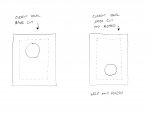Ok, well lets just get one thing out of the way yes it appears I am a moron.
I installed the pool light panel upside down which was pointed out to me after the pool deck contractor noticed it. The question is should I dig out the panel, bust out the foundation concrete and flip the panel? or should I just leave it alone?
The top of the light is about at the bottom of the skimmer BTW.
If I leave it will it look horrible? thanks.
I installed the pool light panel upside down which was pointed out to me after the pool deck contractor noticed it. The question is should I dig out the panel, bust out the foundation concrete and flip the panel? or should I just leave it alone?
The top of the light is about at the bottom of the skimmer BTW.
If I leave it will it look horrible? thanks.





